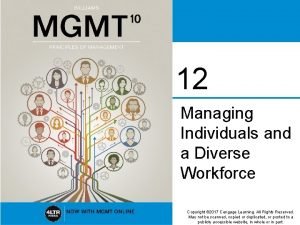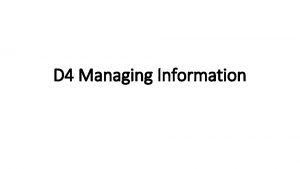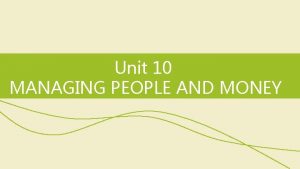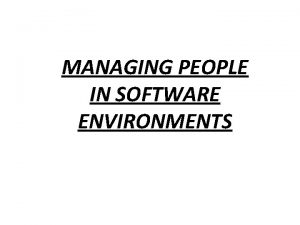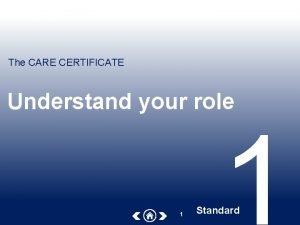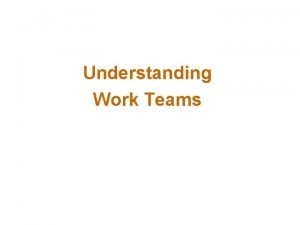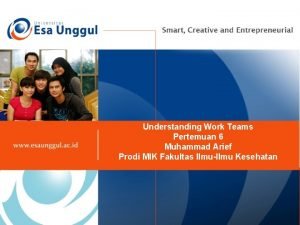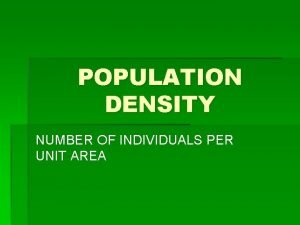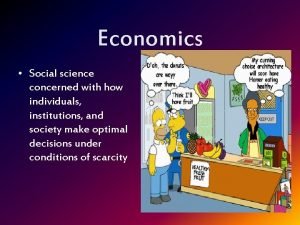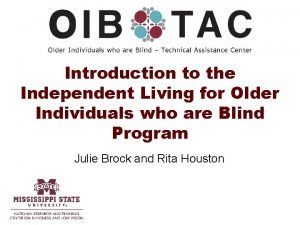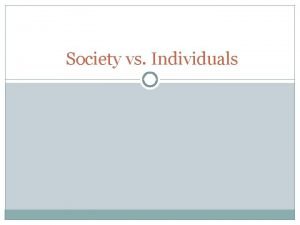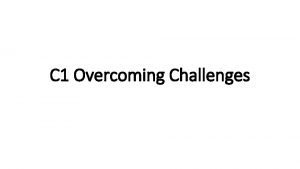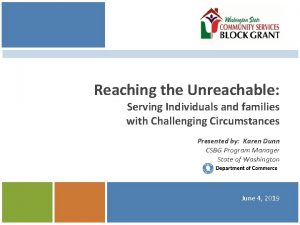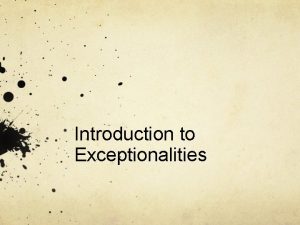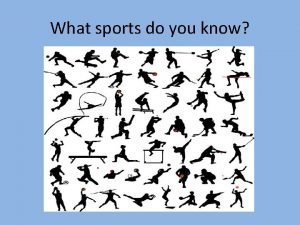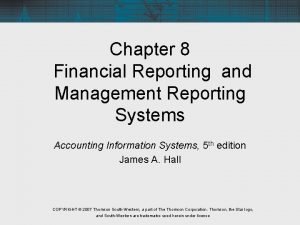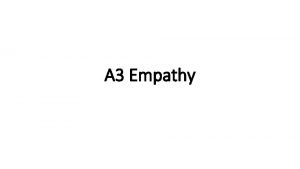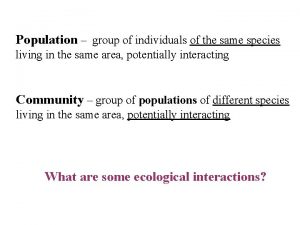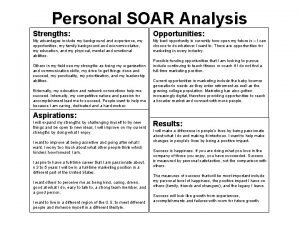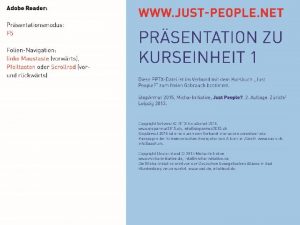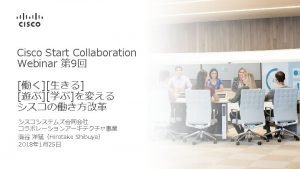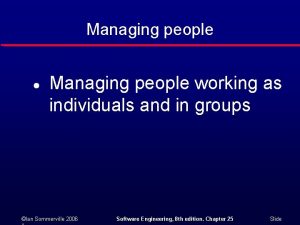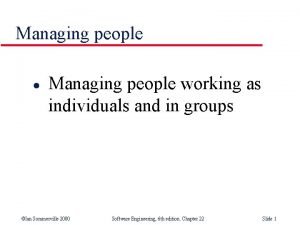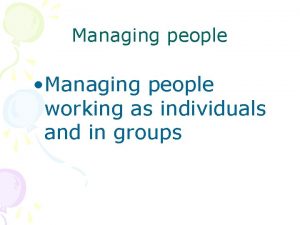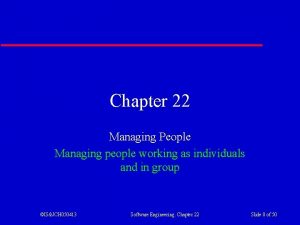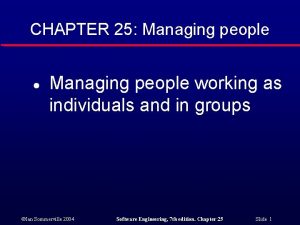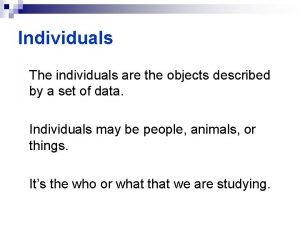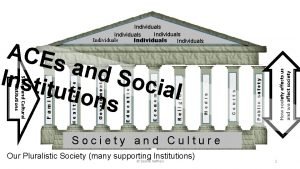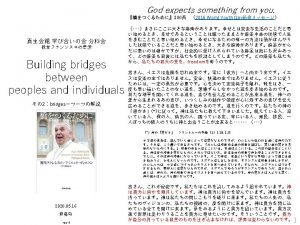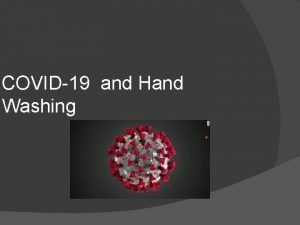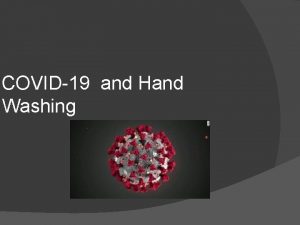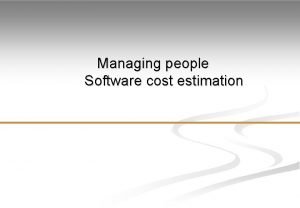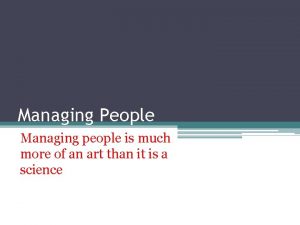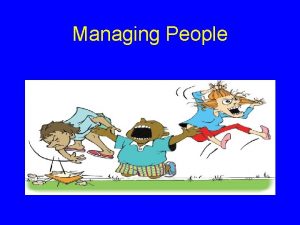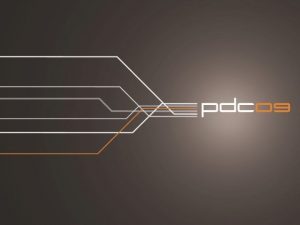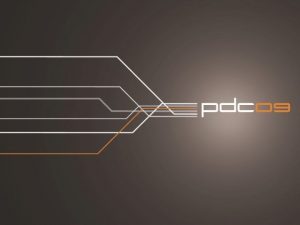Managing people l Managing people working as individuals













































- Slides: 45

Managing people l Managing people working as individuals and in groups ©Ian Sommerville 2000 Software Engineering, 6 th edition. Chapter 22 Slide 1

People in the process l l l People are an organisation’s most important assets The tasks of a manager are essentially people oriented. Unless there is some understanding of people, management will be unsuccessful Software engineering is primarily a cognitive activity. Cognitive limitations effectively limit the software process ©Ian Sommerville 2000 Software Engineering, 6 th edition. Chapter 22 Slide 4

Management activities l l l Problem solving (using available people) Motivating (people who work on a project) Planning (what people are going to do) Estimating (how fast people will work) Controlling (people's activities) Organizing (the way in which people work) ©Ian Sommerville 2000 Software Engineering, 6 th edition. Chapter 22 Slide 5

Limits to thinking l People don’t all think the same way but everyone is subject to some basic constraints on their thinking due to • • • l Memory organisation Knowledge representation Motivation influences If we understand these constraints, we can understand how they affect people participating in the software process ©Ian Sommerville 2000 Software Engineering, 6 th edition. Chapter 22 Slide 6

Memory organisation ©Ian Sommerville 2000 Software Engineering, 6 th edition. Chapter 22 Slide 7

Long-term memory l l Slow access, very large capacity Unreliable retrieval mechanism Slow but finite decay time - information needs reinforced Relatively high threshold - work has to be done to get information into long-term memory. ©Ian Sommerville 2000 Software Engineering, 6 th edition. Chapter 22 Slide 10

Information transfer l l l Problem solving usually requires transfer between short-term memory and working memory Information may be lost or corrupted during this transfer Information processing occurs in the transfer from short-term to long-term memory ©Ian Sommerville 2000 Software Engineering, 6 th edition. Chapter 22 Slide 11

Cognitive chunking ©Ian Sommerville 2000 Software Engineering, 6 th edition. Chapter 22 Slide 12

Knowledge modelling l l l Semantic knowledge of concepts such as the operation of assignment, concept of parameter passing etc. Syntactic knowledge of details of a representation e. g. a C++ for loop. Semantic knowledge seems to be stored in a structured, representation independent way. ©Ian Sommerville 2000 Software Engineering, 6 th edition. Chapter 22 Slide 13

Syntactic/semantic knowledge ©Ian Sommerville 2000 Software Engineering, 6 th edition. Chapter 22 Slide 14

Knowledge acquisition l l l Semantic knowledge through experience and active learning Syntactic knowledge acquired by memorization. New syntactic knowledge can interfere with existing syntactic knowledge. • Problems arise for experienced programmers in mixing up syntax of different programming languages ©Ian Sommerville 2000 Software Engineering, 6 th edition. Chapter 22 Slide 15

Problem solving ©Ian Sommerville 2000 Software Engineering, 6 th edition. Chapter 22 Slide 18

Management Implications l When choosing members of a long term project – should look for problem solving ability, and domain experience rather than specific language skills ©Ian Sommerville 2000 Software Engineering, 6 th edition. Chapter 22 Slide 19

Management Implications l Structured Programming works for a reason • • Based on semantic concepts Short term memory not overloaded ©Ian Sommerville 2000 Software Engineering, 6 th edition. Chapter 22 Slide 20

Motivation l l An important role of a manager is to motivate the people working on a project Motivation is a complex issue but it appears that their are different types of motivation based on • • • Basic needs (e. g. food, sleep, etc. , safety) Social needs (e. g. to be accepted as part of a group) Personal needs (e. g. respect, self-esteem, self realization (personal development) ©Ian Sommerville 2000 Software Engineering, 6 th edition. Chapter 22 Slide 21

Mazlow’s Human needs hierarchy ©Ian Sommerville 2000 Software Engineering, 6 th edition. Chapter 22 Slide 22

Motivating people l l l Motivations depend on satisfying needs It can be assumed that physiological and safety needs are satisfied Social, esteem and self-realization needs are most significant from a managerial viewpoint ©Ian Sommerville 2000 Software Engineering, 6 th edition. Chapter 22 Slide 23

Need satisfaction l Social • • l Esteem • • l Provide communal facilities Allow informal communications Recognition of achievements Appropriate rewards Self-realization • • Training - people want to learn more Responsibility ©Ian Sommerville 2000 Software Engineering, 6 th edition. Chapter 22 Slide 24

Personality types l l The needs hierarchy is almost certainly an oversimplification Motivation should also take into account different personality types: • • • Task-oriented Self-oriented Interaction-oriented ©Ian Sommerville 2000 Software Engineering, 6 th edition. Chapter 22 Slide 25

Motivation balance l l Individual motivations are made up of elements of each class Balance can change depending on personal circumstances and external events However, people are not just motivated by personal factors but also by being part of a group and culture. People go to work because they are motivated by the people that they work with and the work that they do ©Ian Sommerville 2000 Software Engineering, 6 th edition. Chapter 22 Slide 27

22. 2 Group working l Most software engineering is a group activity • l l The development schedule for most non-trivial software projects is such that they cannot be completed by one person working alone Group interaction is a key determinant of group performance Flexibility in group composition is limited • Managers must do the best they can with available people ©Ian Sommerville 2000 Software Engineering, 6 th edition. Chapter 22 Slide 28

Time distribution ©Ian Sommerville 2000 Software Engineering, 6 th edition. Chapter 22 Slide 29

Group composition l Group composed of members who share the same motivation can be problematic • • • l l l Task-oriented - everyone wants to do their own thing Self-oriented - everyone wants to be the boss Interaction-oriented - too much chatting, not enough work An effective group has a balance of all types Can be difficult to achieve because most engineers are task-oriented Need for all members to be involved in decisions which affect the group ©Ian Sommerville 2000 Software Engineering, 6 th edition. Chapter 22 Slide 30

Group leadership l l Leadership depends on respect not titular status There may be both a technical and an administrative leader Democratic leadership is more effective that autocratic leadership A career path based on technical competence should be supported ©Ian Sommerville 2000 Software Engineering, 6 th edition. Chapter 22 Slide 31

Group cohesiveness l l In a cohesive group, members consider the group to be more important than any individual in it Advantages of a cohesive group are: • • Group quality standards can be developed Group members work closely together – learn from each other and together Team members get to know each other’s work Egoless programming where members strive to improve each other’s programs can be practiced ©Ian Sommerville 2000 Software Engineering, 6 th edition. Chapter 22 Slide 32

Developing cohesiveness l l Cohesiveness is influenced by factors such as the organizational culture and the personalities in the group Cohesiveness can be encouraged through • • • l Social events Developing a group identity and territory Explicit team-building activities Openness with information is a simple way of ensuring all group members feel part of the group ©Ian Sommerville 2000 Software Engineering, 6 th edition. Chapter 22 Slide 33

Group loyalties l Group members tend to be loyal to cohesive groups • l l Downside – if leadership changes to somebody outside the group, they may face resistance from the group 'Groupthink' is preservation of group irrespective of technical or organizational considerations Management should act positively to avoid groupthink by forcing external involvement with each group ©Ian Sommerville 2000 Software Engineering, 6 th edition. Chapter 22 Slide 34

Group communications l l l Good communications are essential for effective group working Information must be exchanged on the status of work, design decisions and changes to previous decisions Good communications also strengthens group cohesion as it promotes understanding ©Ian Sommerville 2000 Software Engineering, 6 th edition. Chapter 22 Slide 35

Group communications l l Group Size Status of group members • l Group Structure and Communication channels • l Too many people of the same personality type can be a problem Sexual composition of group • l Communications channelled though a central coordinator tend to be ineffective Personalities in groups • l Higher status members tend to dominate conversations Mixed-sex groups tend to communicate better Physical work environment ©Ian Sommerville 2000 Software Engineering, 6 th edition. Chapter 22 Slide 36

Group organization l l l Software engineering group sizes should be relatively small (< 8 members) Break big projects down into multiple smaller projects To be discussed in turn: • Small teams may be organized in an informal, democratic way • Extreme variant – Extreme Programming • Chief programmer teams try to make the most effective use of skills and experience ©Ian Sommerville 2000 Software Engineering, 6 th edition. Chapter 22 Slide 37

Democratic team organisation l l The group acts as a whole and comes to a consensus on decisions affecting the system The group leader serves as the external interface of the group but does not allocate specific work items Rather, work is discussed by the group as a whole and tasks are allocated according to ability and experience This approach is successful for groups where all members are experienced and competent ©Ian Sommerville 2000 Software Engineering, 6 th edition. Chapter 22 Slide 38

Extreme programming groups l l l Extreme programming groups are variants of democratic organization Extremely rapid prototyping In extreme programming groups, some ‘management’ decisions are devolved to group members Programmers work in pairs and take a collective responsibility for code that is developed Extreme Programming Explained: embrace change, by Kent Beck, Addison Wesley 2000 ©Ian Sommerville 2000 Software Engineering, 6 th edition. Chapter 22 Slide 39

12 Practices of Extreme Programming l l l l Customer On-Site with development Daily Planning, involving customer/ developers Small Releases Simple Design Continuous Integration Testing constantly – planned in advance Strict coding standards Refactoring (re-work) encouraged Collective Ownership of Code Pair Programming (at same computer) 40 hour work week Collective vision (“metaphor”) Practices work as a group, they depend on each other! ©Ian Sommerville 2000 Software Engineering, 6 th edition. Chapter 22 Slide 40

Practices work as a group, they depend on each other! l l l Planning is dependent on On Site Customer Small Releases is dependent on Planning Small Releases is dependent on Simple Design Continuous Integration is dependent on Small Releases Continuous Integration is dependent on Testing Refactoring is dependent on Testing Collective Ownership is dependent on Coding Standards Collective Ownership is dependent on Pair Programming 40 Hour Work Week is dependent on Continuous Integration … ©Ian Sommerville 2000 Software Engineering, 6 th edition. Chapter 22 Slide 41

Watch Out l l l l Will not work in Dibertesque corporations Will not work for large projects (> 20 people) Will not work if customers are slow to give feedback Will not work if programmers are physically separate Generally seems to assume OO environment Not Appropriate if maintaining Legacy Code or earlier release structure is important May require highly qualified and motivated staff in order to be successful Concern – Return of quick and dirty? ©Ian Sommerville 2000 Software Engineering, 6 th edition. Chapter 22 Slide 42

Chief programmer teams (IBM developed) ©Ian Sommerville 2000 Software Engineering, 6 th edition. Chapter 22 Slide 43

Problems l l This chief programmer approach, in various forms, has been successful However, it suffers from a number of problems • • Talented designers and programmers are hard to find. Without exceptional people in these roles, the approach will fail Other group members may resent the chief programmer taking the credit for success so may deliberately undermine his/her role While backup programmer is prepared to take over for chief programmer, if both the chief and deputy programmer are unavailable, there is a high risk that the project will fail Organizational structures and programmer levels (e. g. Sr Programmer etc) may be unable to accommodate this type of group ©Ian Sommerville 2000 Software Engineering, 6 th edition. Chapter 22 Slide 45

22. 3 Choosing and keeping people l l Choosing people to work on a project is a major managerial responsibility Appointment decisions are usually based on • • • l information provided by the candidate (their resumé or CV) information gained at an interview recommendations from other people who know the candidate Some companies use psychological or aptitude tests • There is no agreement on whether or not these tests are actually useful ©Ian Sommerville 2000 Software Engineering, 6 th edition. Chapter 22 Slide 46

Staff selection factors

Working environments l Physical workplace provision has an important effect on individual productivity and satisfaction • • • l Comfort Privacy Facilities Health and safety considerations must be taken into account • • • Lighting Heating Furniture ©Ian Sommerville 2000 Software Engineering, 6 th edition. Chapter 22 Slide 48

Environmental factors l l l Privacy - each engineer requires an area for uninterrupted work Outside awareness - people prefer to work in natural light Personalization - individuals adopt different working practices and like to organize their environment in different ways ©Ian Sommerville 2000 Software Engineering, 6 th edition. Chapter 22 Slide 49

Workspace organisation l Workspaces should provide private spaces where people can work without interruption • l Providing individual offices for staff has been shown to increase productivity!! However, teams working together also require spaces where formal and informal meetings can be held ©Ian Sommerville 2000 Software Engineering, 6 th edition. Chapter 22 Slide 50

Office layout – Really Nice! ©Ian Sommerville 2000 Software Engineering, 6 th edition. Chapter 22 Slide 51

22. 4 The People Capability Maturity Model l l Intended as a framework for managing the development of people involved in software development Five stage model • • • Initial. Ad-hoc people management Repeatable. Policies developed for capability improvement Defined. Standardized people management across the organization Managed. Quantitative goals for people management in place Optimizing. Continuous focus on improving individual competence and workforce motivation ©Ian Sommerville 2000 Software Engineering, 6 th edition. Chapter 22 Slide 52

P-CMM Objectives l l To improve organisational capability by improving workforce capability To ensure that software development capability is not reliant on a small number of individuals To align the motivation of individuals with that of the organization To help retain people with critical knowledge and skills ©Ian Sommerville 2000 Software Engineering, 6 th edition. Chapter 22 Slide 54
 Surface-level diversity
Surface-level diversity Hot working and cold working difference
Hot working and cold working difference Differentiate between hot working and cold working
Differentiate between hot working and cold working Hard work and smart work
Hard work and smart work Proses pengerjaan logam
Proses pengerjaan logam Hot working of metals is carried out
Hot working of metals is carried out Working practices for managing information
Working practices for managing information Sign of affection candy
Sign of affection candy Unit 10 managing people
Unit 10 managing people Managing people in software engineering
Managing people in software engineering Care certificate understand your role
Care certificate understand your role Understanding work teams
Understanding work teams Unit 12 supporting individuals with additional needs
Unit 12 supporting individuals with additional needs The activities that independent individuals groups
The activities that independent individuals groups Team vs working group
Team vs working group Individuals: an essay in descriptive metaphysics
Individuals: an essay in descriptive metaphysics The number of individuals per unit area
The number of individuals per unit area Healthy confident individuals
Healthy confident individuals Economics is the social science concerned with
Economics is the social science concerned with Idea 97
Idea 97 Individuals and families diverse perspectives
Individuals and families diverse perspectives Photo/drawing of individuals/groups/institutions
Photo/drawing of individuals/groups/institutions Serving individuals and families
Serving individuals and families Individual resources
Individual resources Older individuals who are blind program
Older individuals who are blind program Better health for individuals
Better health for individuals Appearance vs reality in a doll's house
Appearance vs reality in a doll's house Team definition
Team definition Enabling individuals to overcome challenges
Enabling individuals to overcome challenges How do the 6cs prevent discrimination
How do the 6cs prevent discrimination Risk management for enterprises and individuals
Risk management for enterprises and individuals Serving individuals and families
Serving individuals and families The process of attracting individuals on a timely basis
The process of attracting individuals on a timely basis Individuals with exceptionalities
Individuals with exceptionalities Disadvantages of sports
Disadvantages of sports Explain the features of the gls and frs
Explain the features of the gls and frs Secretary meaning
Secretary meaning Attachment and emotional resilience theory
Attachment and emotional resilience theory Parasitism
Parasitism Gene pool
Gene pool Personal soar analysis example
Personal soar analysis example Gilligan
Gilligan People killin people dying
People killin people dying Recovery community
Recovery community People in media vs people as media
People in media vs people as media Justpeople
Justpeople
